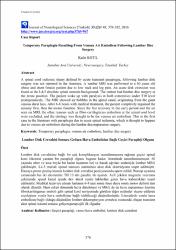| dc.contributor.author | Kotil, Kadir | en_US |
| dc.date.accessioned | 2019-10-29T18:00:15Z | |
| dc.date.available | 2019-10-29T18:00:15Z | |
| dc.date.issued | 2016 | |
| dc.identifier.issn | 1300-1817 | |
| dc.identifier.uri | http://www.trdizin.gov.tr/publication/paper/detail/TWpVeU56YzJOZz09 | |
| dc.identifier.uri | https://hdl.handle.net/20.500.12294/2410 | |
| dc.description.abstract | Lomber disk cerrahisine bağlı bir çok komplikasyon tanımlanmasına rağmen geçici spinal kord iskemisi yaratan bir parapleji olgusu bugune kadar literatürde tanımlanmamıştır. 60 yaşında obez ve kısa boylu bir kadın hastanın bel ve bacak ağrıları nedeniyle lomber MRG çekilmiştir. L4-5 mutlak spinal stenosis zemininde akut disk ekstrüzyonu tespit edilmiştir. Hastaya prone pozisyonunda lomber disk cerrahisi pozisyonunda opere edildi. Postop uyanma esmasında her iki ekstremite TH 10 altı paralizi ile uyandı. Acil çekilen magnetic rozenans çekiminde spinal kanal içinde dev dural venöz laklardan giren hava kabarcıkları tespit edilmiştir. Medikal tedaviye alınan hastanın 6-8 saat sonra önce duyu sonra motor defisiti tam olarak düzeldi. Hem erken dönemde hızla düzelmesi ve MRG de de hava saptanması üzerine fibrokartilogenaz emboli gibi spinal kord seviyesinde görülen diğer nedenler ekarte edilerek etyolojinin venöz hava embolisine bağlı olabileceği düşünülmüştür. Literatürde venöz hava embolisine bağlı olduğu düşünülen lomber dekompresyon cerrahisi esnasında oluşan transient akut spinal iskemi sonucu gelişen paraplejili ilk olgudur. | en_US |
| dc.description.abstract | A spinal cord ischemic injury defined by acute transient paraplegia, following lumbar disk surgery was not reported in the literature. A lumbar MRI was performed to a 60 years old obese and short female patient due to low back and leg pain. An acute disk extrusion was found at the L4-5 absolute spinal stenosis background. The patient had lumbar disc surgery at the prone position. The patient woke up with paralysis in both extremities under T10 level postoperatively. The MRI showed air bubbles in the spinal canal, originating from the giant venous dural lacs. After 6-8 hours with medical treatment, the patient completely regained the sensory first, then the motor function. Since the fast recovery in the early period and the air seen on MRI, the other reasons such as fibro cartilaginous embolism at the spinal cord level were excluded, and the etiology was thought to be the venous air embolism. This is the first case in the literature with paraplegia due to acute spinal ischemia, which is thought to happen due to venous air embolism during the lumbar decompression surgery. | en_US |
| dc.language.iso | tur | en_US |
| dc.relation.ispartof | Journal of Neurological Sciences (Turkish) | en_US |
| dc.rights | info:eu-repo/semantics/openAccess | en_US |
| dc.subject | Nörolojik Bilimler | en_US |
| dc.title | Temporary Paraplegia Resulting From Venous Air Embolism Following Lumbar Disc Surgery | en_US |
| dc.title.alternative | Lomber Disk Cerrahisi Sonucu Gelişen Hava Embolisine Bağlı Geçici Parapleji Olgusu | en_US |
| dc.type | article | en_US |
| dc.department | İstanbul Arel Üniversitesi, Sağlık Bilimleri Yüksekokulu, Fizyoterapi ve Rehabilitasyon | en_US |
| dc.identifier.volume | 33 | en_US |
| dc.identifier.issue | 2 | en_US |
| dc.identifier.startpage | 378 | en_US |
| dc.identifier.endpage | 382 | en_US |
| dc.relation.publicationcategory | Makale - Uluslararası Hakemli Dergi - Kurum Öğretim Elemanı | en_US |
| dc.institutionauthor | Kotil, Kadir | en_US |


















